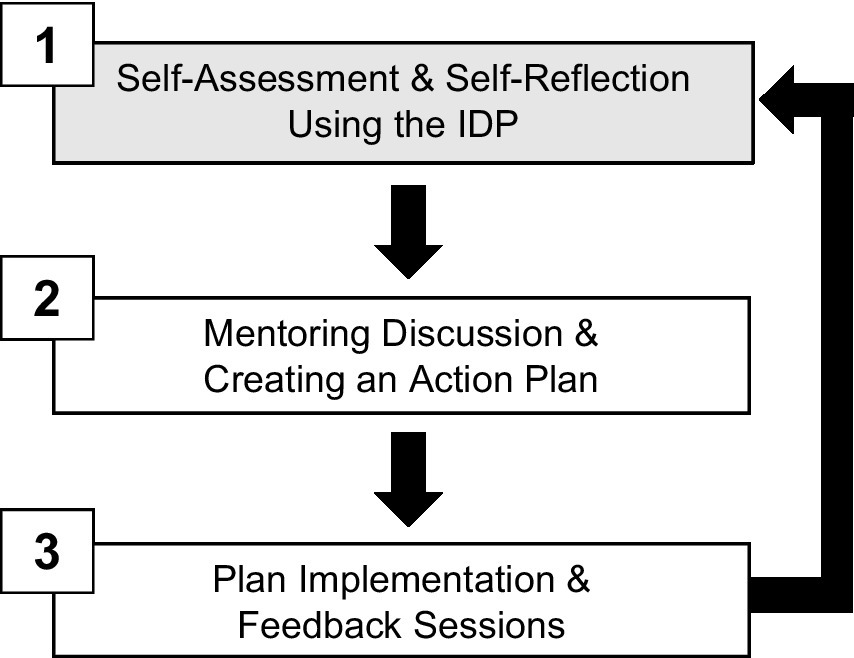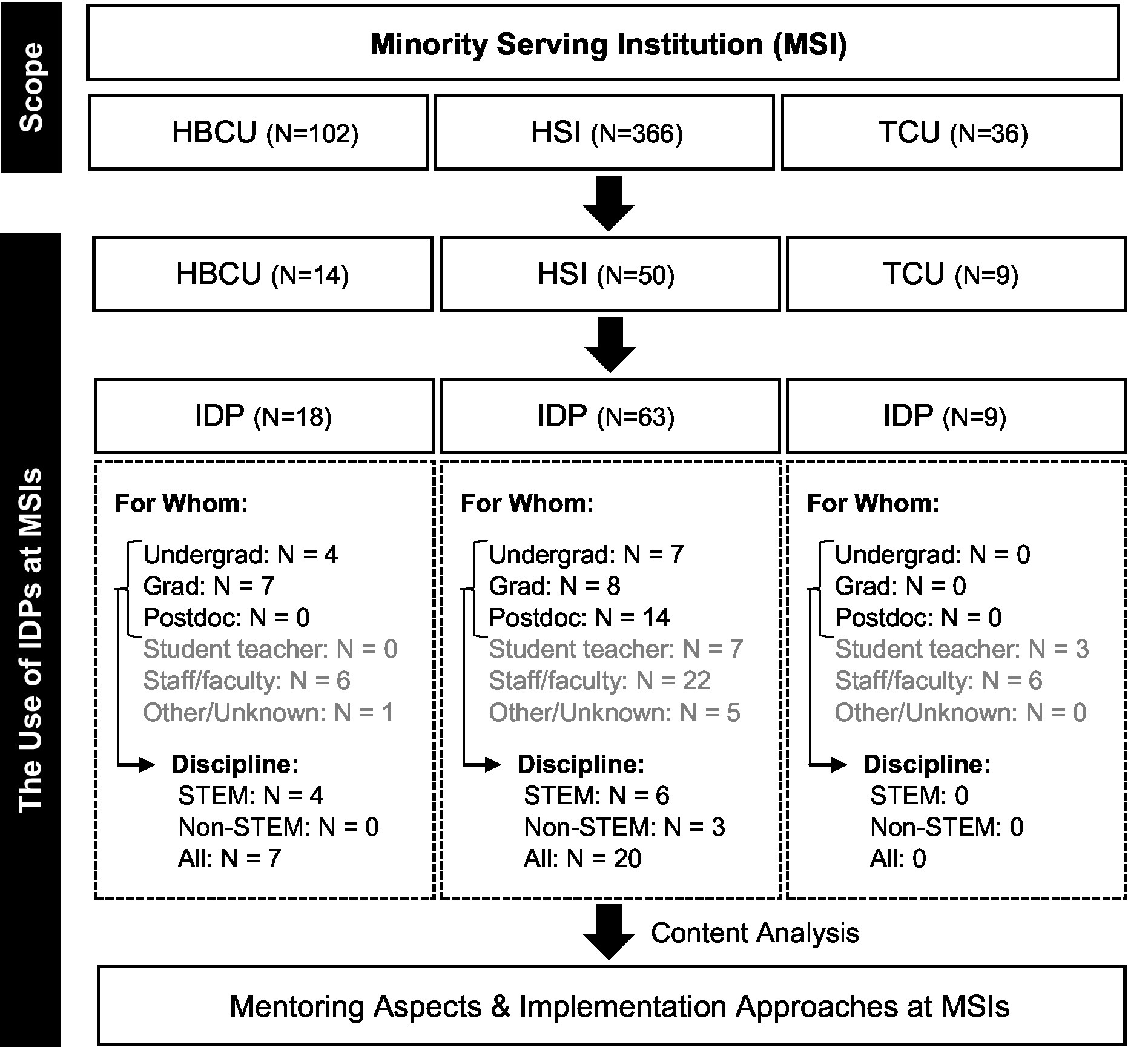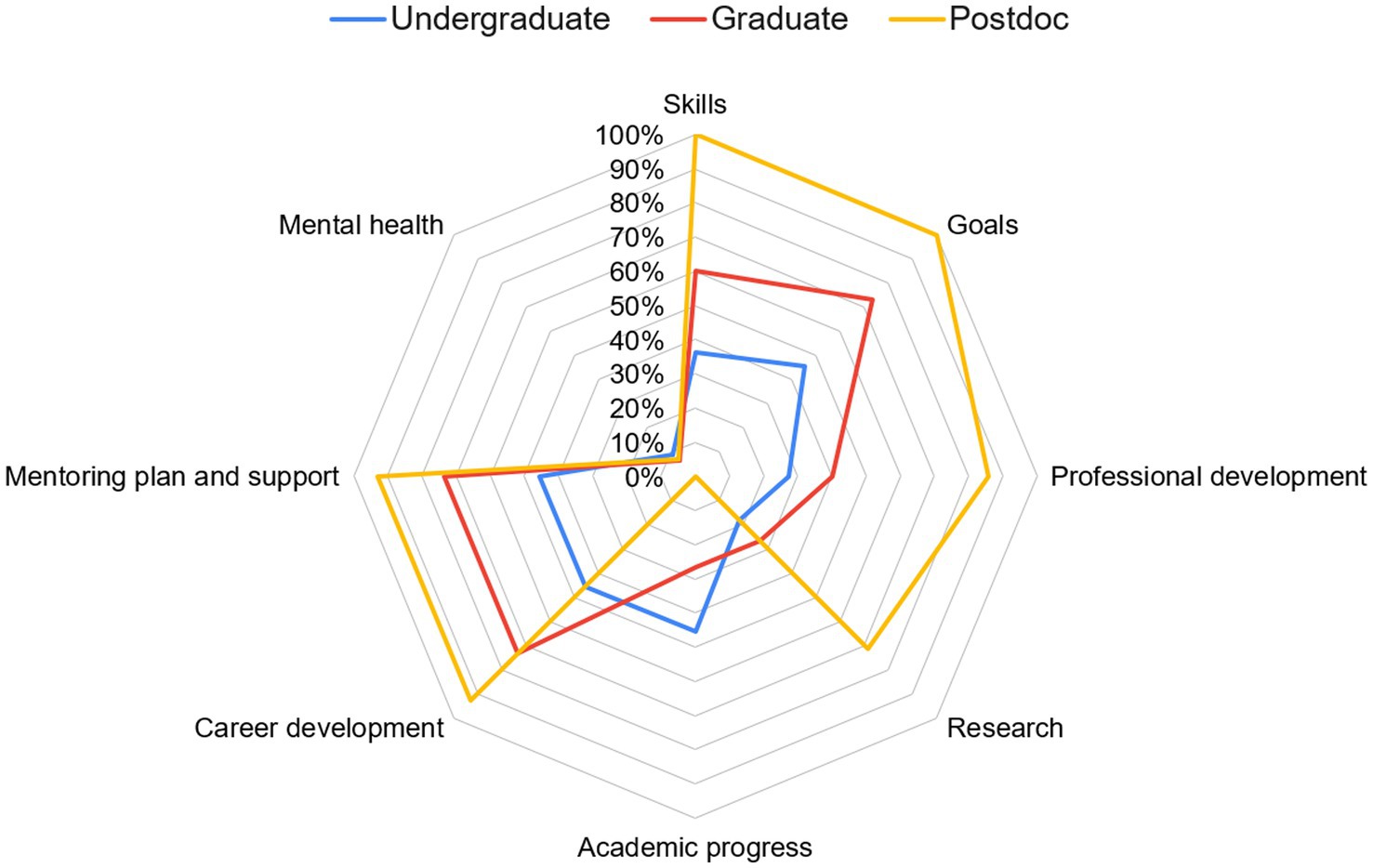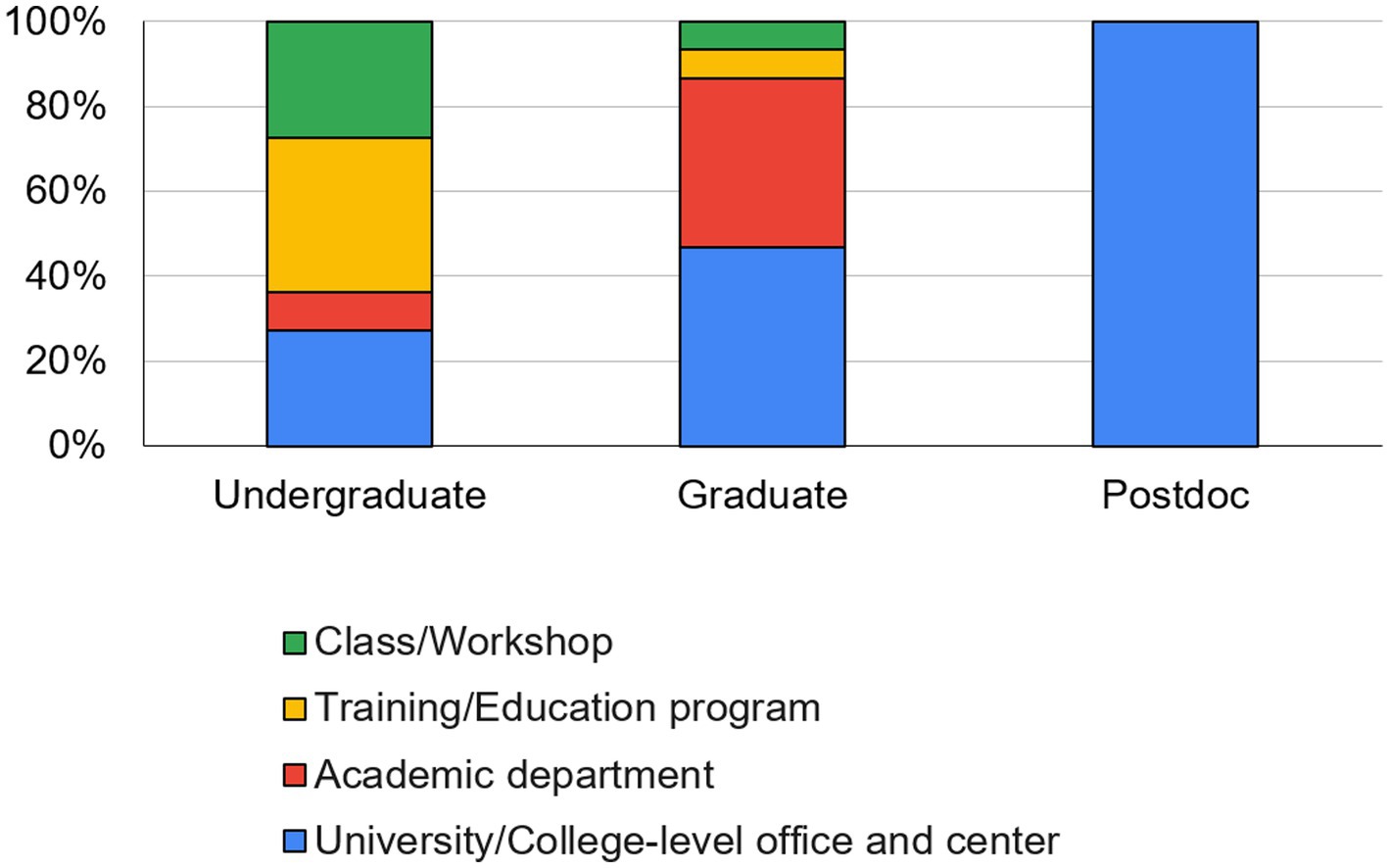- 1School of Education, Virginia Commonwealth University, Richmond, VA, United States
- 2School of Education and Human Sciences, The University of Kansas, Lawrence, KS, United States
The Individual Development Plan (IDP) is a common mentoring tool in higher education. Students and postdoctoral researchers can use an IDP to facilitate conversations with their mentors and create action plans to support future goals. The entire process helps mentees achieve both short- and long-term objectives. Little is known about how historically underrepresented minority groups are supported during this process. This study investigated IDP implementation at 504 minority serving institutions (MSIs) that primarily serve African American, Hispanic/Latinx, and Native-American populations. Using content analysis, we systematically reviewed the publicly available IDP tools and policies at each MSI. Although several crucial mentoring components and implementation strategies were identified, there was a noticeable absence of emphasis on multicultural mentoring guidance and psychosocial support throughout the process. Our findings offer decision-makers and faculty mentors insights into supporting minority trainees and lay the foundation for future research in the field of IDPs.
1. Introduction
Mentoring is one of the most important strategies for increasing postsecondary success and supporting higher education trainees (U.S. Department of Education, 2012). Promoted by federal agencies (e.g., the National Institutes of Health [NIH]) and professional organizations (e.g., the American Association for the Advancement of Science), the Individual Development Plan (IDP) has become a common mentoring tool in higher education. Students and postdoctoral researchers can use the IDP to facilitate mentoring conversations with their mentors, advisors, and principal investigators (PIs) and create an action plan to guide future progress. The entire process aims to help mentees achieve both short and long-term objectives.
A recent empirical study indicated that IDPs have a positive impact on mentoring support and career preparedness among doctoral trainees in the life sciences (Chang et al., 2021). Despite this, the use of IDP is extremely understudied, especially for historically underrepresented minority groups. It is unclear how minority groups in higher education are supported using an IDP during the mentoring process. To fill the literature gap, this study investigated how the IDP was implemented in U.S. minority serving institutions (MSIs). We reviewed the IDP tools and policies at each MSI to analyze key mentoring aspects and implementation approaches. These findings could provide decision-makers and mentors/advisors/PIs with insights for supporting minority groups by identifying areas in which their institution’s IDP process could be strengthened.
1.1. The individual development plan (IDP)
The IDP concept was introduced in education in the early 1970s (Foster and Foster, 1973). In 2002, the U.S. Federation of American Societies for Experimental Biology (FASEB) started promoting the use of the IDP in pre- and post-doctoral biological science programs. In 2014, the National Institutes of Health (NIH) launched a policy strongly recommending graduate students and postdoctoral researchers use the IDP with their PIs in funded training programs (National Institutes of Health, 2014). As a result, an increasing number of higher education institutions and federal funding agencies encourage (or even require) students and postdoctoral researchers to use the IDP tool with their mentors. The U.S. Chips and Science Act, 2022 also suggested that the IDP should be part of the mentoring and professional development process for training STEM graduate students and postdoctoral researchers (Chips and Science Act, 2022).
Professional associations and universities have created various IDP tools. IDPs may emphasize various aspects of mentoring. In general, despite varying specifics, each IDP contains multiple sets of assessments and questions for mentees to self-assess their skills, reflect on their current status, explore career paths, identify career goals, ask feedback from mentors, and create action plans with their mentors (Clifford, 2002; Hobin et al., 2012, 2014; Vanderford et al., 2018a,b; Thompson et al., 2020). The overall IDP process is illustrated in Figure 1. Initially, mentees use the IDP to conduct self-assessments and self-reflections. After completing these assessments, mentees bring them to mentoring sessions to create action plans with their mentors. Finally, mentors schedule follow-up meetings to track mentees’ progress and offer feedback. This process is repeated until graduation or the end of the project/program. Although the IDP is a common mentoring tool in higher education, empirical studies are still needed to improve mentoring practices (Chang et al., 2021).
Given that historically underrepresented minority groups are disproportionately affected by educational inequity, there is a need to investigate how to enhance support for these students during higher education mentoring, particularly through the use of IDPs. Recognizing the unique role played by MSIs in supporting these students (National Academies of Sciences, Engineering, and Medicine, 2019a,b), we systematically reviewed the IDP tools and policies within MSIs. The review aims to identify the crucial mentorship components and implementation strategies inherent to these IDPs. The research could provide valuable insights into optimizing the utilization of IDPs to enhance support for minority students and advance the ideals of equity and inclusivity in higher education.
2. Materials and methods
This study investigated the use of IDPs at MSIs that primarily serve African American, Hispanic/Latinx, and Native-American populations, including all Historically Black Colleges and Universities (HBCUs, n = 102), Hispanic-Serving Institutions (HSIs, n = 366), and Tribal Colleges and Universities (TCUs, n = 36) as of April 2021 (Office of Diversity, Inclusion and Civil Rights, 2021). Given that IDP resources are often publicly available, especially during the COVID-19 pandemic, we collected related information (e.g., IDP tools, policies, implementations, etc.) through each university’s website between April 2021 and August 2021. This period is typically a time point for students to conduct self-assessments and self-reflections through the IDP, allowing us to collect maximum information from each institution. The keywords we searched were (1) “individual development plan” within each university’s website and (2) “individual development plan” plus “university name” in the Google search engine.
Based on our search results, 14 of 102 HBCUs, 50 of 366 HSIs, and 9 of 36 TCUs utilized the IDP to support their undergraduate students, graduate students, postdoctoral researchers, student teachers, staff, faculty members, and other members. The present study limited the scope to IDPs for undergraduate students, graduate students, and postdoctoral researchers. Among the 14 HBCUs, we found 11 IDPs: 4 were for undergraduate students, and 7 were for graduate students; 4 were for STEM disciplines, and 7 were for all disciplines. Within 50 HSIs, we found 29 IDPs: 7 were for undergraduate students, 8 were for graduate students, and 14 were for postdoctoral researchers; 6 were for STEM disciplines, 3 were for non-STEM disciplines, and 20 were for all disciplines. Within the 9 TCUs, none of the IDPs were for undergraduate students, graduate students, or postdoctoral researchers. Detailed information may be found in Figure 2.
Thematic analysis was employed to examine two components: (1) the mentoring aspects that MSIs emphasized within the IDPs, and (2) the IDP implementation approaches that the MSIs utilized to support their students and postdoctoral researchers. The analysis phases included (1) familiarization with the data, (2) generating initial codes, (3) searching for potential themes, (4) reviewing themes and thematic maps, (5) refining and defining themes, and (6) reporting results (Braun and Clarke, 2006; Vaismoradi et al., 2013). Two coders were used to code the dataset. The coders examined the differences until agreement was reached. Finally, two MSI reviewers were invited to review the coding and thematic analysis results, provide feedback, and confirm their validity.
3. Results
3.1. Various IDP tools used at MSIs
Although some MSIs (23%) used existing IDP tools developed by professional associations and higher education institutions, the majority (50%) developed and created customized IDP tools for their students or postdoctoral researchers. For the remaining MSIs (27%), we were unable to identify the IDPs they used, but we could still determine their mentoring aspects and implementation methods through their website/document descriptions.
Examples of existing IDP tools that were utilized at MSIs included myIDP developed by the American Association for the Advancement of Science, FASEB IDP by the Federation of American Societies for Experimental Biology, ChemIDP by the American Chemical Society, ImaginePhD by the Graduate Career Consortium, APA IDP by the American Psychological Association, and other tools such as those developed by the University of California San Diego, the University of Pennsylvania, the University of Southern California, Stanford University’s Office of Postdoc Affairs, or the University of Minnesota Medical School.
3.2. Mentoring aspects emphasized at MSIs
Themes emerged during data analysis regarding the mentoring aspects within the IDPs of MSIs. The MSIs’ IDP tools included eight mentoring aspects: skills, goals, professional development, research, academic progress, career development, mentoring plan and support, and mental health. Although these eight components were identified, each IDP covered only a few aspects. Figure 3 displays the mentoring patterns at MSIs by academic degree levels (undergraduate, graduate, and postdoc). For trainees with a higher degree level, a higher percentage of IDPs emphasized their skills, goals, professional development, research, career development, and mentoring support and planning. For trainees with a lower degree level, a higher percentage of IDPs focused more on academic progress. The results also revealed that the mental health component was notably absent from the majority of IDPs at the MSIs.
The themes that surfaced predictably focused on personal and professional growth. An illustrative instance for each thematic category is presented below for substantiating purposes, but not in an effort to highlight specific programs or implementation practices. For instance, the University of Arizona’s (HSI) Office of Postdoctoral Affairs emphasized the importance of skills such as inquiry, discovery, and creation; disciplinary expertise and interdisciplinary connections; leadership; career development; project and people management; communication; valuing diversity and inclusion; and interpersonal and personal effectiveness. Goals were exemplified by the requirements of Nova Southeastern University (HSI), where doctoral-level psychology students are required to engage in self-reflection and discuss their academic and professional knowledge goals, clinical skills and experience goals, scientific and scholarly achievement goals, professional mission statements and career goals, and other significant objectives for the upcoming years. Professional development was the focus for students in the biology graduate program at New Mexico State University (HSI). Graduate students are encouraged to reflect on their major strengths and previous training related to professional goals, while simultaneously identifying their weaknesses and training gaps. Research components, highlighted by postdoctoral IDPs at Florida Atlantic University (HSI), outline current and future research projects, participation in professional conferences, publication records, publication plants, and grant applications. At Meharry Medical College (HBCU), mentors help monitor academic progress by encouraging discussions regarding courses to be taken, the formation of an instruction committee, dissertation proposals and fellowship writing projects, as well as publications and presentations. Career development for law school students at Florida International University (HSI) involved providing assessments to identify career options that align with students’ interests, skills, and values. Mentoring plans and support are actively encouraged at the University of California, Santa Cruz (HSI). Postdoctoral researchers collaborate with their faculty mentors to create annual goals and long-term plans encompassing discipline-specific conceptual knowledge, profession and research skill development, responsible conduct of research, communication skills, professionalism, and leadership and management skills. The University of California, Irvine (HSI) was the only IDP to mention mental health, including work-life balance, overall well-being, and mitigation of burnout among students and researchers.
3.3. IDP implementation approaches at MSIs
IDP implementation at MSIs was summarized using four approaches: class/workshop, training/education program, academic department, and university/college-level office and center. Figure 4 shows the implementation patterns by academic degree level (undergraduate, graduate, or postdoc). A class/workshop approach would entail an institution offering a separate training that teaches students how to use the IDP. A training/education approach would entail a training program, typically funded by an external agency, requiring students to use an IDP to receive mentoring support. An academic department may list the IDP requirement in the department handbook, “strongly encouraging” their trainees to use an IDP with their mentors to improve their core competencies. At the highest level, university/college may require trainees to learn how to use the IDP. Overall, the higher the academic degree (i.e., graduate and postdoctoral), the higher the percentage of IDPs required/encouraged by department-level or university/college-level units. IDPs for undergraduate students were more likely to be promoted through classes, workshops, or other training/education programs.
Specific universities have implemented IDPs in various academic contexts. For instance, at the North Carolina Central University (HBCU), an IDP workshop was organized as part of the “Black Women in STEM Symposium,” aiming to educate undergraduate students on the utilization of IDPs. Similarly, the Learning Environment and Academic Research Network program at the University of Central Florida (HSI), funded by the National Science Foundation, required trainees to become proficient in IDP usage through training and guidance provided by staff and mentors. Within academic departments, the Clinical Psychology Joint Doctoral Program at San Diego State University (HSI) has PhD students develop an IDP at the onset of each academic year and subsequently update it annually to account for changes in their careers and research aspirations. The graduate division of the University of California, Irvine (HSI) actively encourages all postdoctoral scholars to employ an IDP in collaboration with their mentors, recognizing its potential to enhance core competencies. Texas Tech University (HSI) is another noteworthy example, as the IDP is explicitly listed in the strategic plan of the graduate school, which aims to increase participation in the IDP program by 20% by 2025. These instances demonstrate varying levels of institutional commitment to implementing IDPs as a tool for personal and professional growth in academia.
4. Discussion
Our study significantly advances our understanding of how IDPs are implemented in MSIs. We systematically reviewed the key mentoring aspects and implementation methods for IDPs at 504 MSIs. Various IDPs have been employed across these institutions. The primary mentoring dimensions were goals, professional development, research, academic progress, career development, mentoring plans and support, and mental health. Interestingly, the emphasis on these mentoring aspects varied according to the specific student populations served, which included undergraduates, graduate students, and postdoctoral trainees. We observed greater emphasis on academic progress for undergraduate students, likely because undergraduate studies mark a significant transition from high school. Related IDP training was delivered through classes, workshops, training programs, or university/college-level offices and centers.
However, when it comes to graduate students and postdoctoral researchers, who receive support from their advisors and PIs and have acquired a level of maturity through their postsecondary education, the focus of mentoring undergoes a significant transformation. It shifts from tracking academic progress to a more comprehensive emphasis on personal and professional growth. Growth encompasses a wide spectrum of aspects such as skill enhancement, professional development, research development, goal setting, nurturing mentor-mentee relationships, and fostering career advancement. Consequently, these dimensions have become vital areas that necessitate dedicated support from departmental or university/college-level resources. This finding aligns with the recommendations of the Chips and Science Act, 2022.
The study also identified a significant gap in multicultural mentoring guidance among IDPs at MSIs. Successful mentorship requires faculty to possess an understanding of the identity-related obstacles faced by their mentees to foster the growth of underrepresented minority students (National Academies of Sciences, Engineering, and Medicine, 2019b). Educating mentors in culturally aware and responsive mentorship practices is one way that mentors can effectively work with trainees from diverse backgrounds (National Academies of Sciences, Engineering, and Medicine, 2019b). While it is possible that some level of multicultural awareness naturally occurs in mentoring relationships at MSIs, our findings revealed a lack of intentional multicultural mentoring guidance within their IDPs. As locations such as HBCU’s become more diverse (National Center for Education Statistics, n.d.) and professors and faculty at HSIs are not as diverse as their student bodies (Boland et al., 2017), the lack of intentional multiculturally aware mentoring feels like oversight. Therefore, it is necessary to develop multicultural mentoring guidance to improve the mentoring process using the IDP.
Another noteworthy aspect highlighted by this study is the limited inclusion of psychosocial support, particularly concerning mental health, in most MSIs’ IDPs. The findings of mentoring aspects highlight the current emphasis on instrumental support (e.g., skills, professional development, research, academic progress, career development) at MSIs. However, psychosocial support (e.g., mental health) was not highlighted in most MSIs’ IDPs (i.e., step 1 in Figure 1), especially during the COVID-19 pandemic. Only one IDP was concerned with issues of work-life balance, well-being, and burnout. As psychosocial support is an integral component of the critical mentoring process (Eby et al., 2013), it is worth investigating how psychosocial support was provided during the IDP discussion (i.e., step 2 in Figure 1) and follow-up feedback sessions (i.e., step 3 in Figure 1) in the future.
While our study provides valuable insights, it is essential to acknowledge its limitations. Our sampling procedures were confined to publicly available IDP documents, potentially excluding those stored in institution-specific drives or programs. To address this limitation, we made generalizations about IDPs across HBCUs, HSIs, and TCUs, and focused on observed trends. Another limitation was the constrained timeframe for document collection. Future research could delve into the differences in the IDP process by comparing pre-COVID and current IDP themes or conducting a large-scale comparative study of MSIs and non-MSIs. Additionally, there is a pressing need for further investigation into how multicultural mentoring and psychosocial support can be effectively integrated throughout the IDP process. Identifying the best practices for addressing these limitations will contribute to a more comprehensive understanding of IDP implementation in MSIs.
In conclusion, this study provides methodological and practical contributions to the literature on IDP implementation and mentoring practices in MSIs. Methodologically, it offers one of the first examinations of how MSIs utilize IDPs to support their students and postdoctoral researchers. Our findings, while not encompassing Asian American and Pacific Islander Serving Institutions (AAPISIs) and newly recognized MSIs from 2022 onwards, still hold substantial relevance for higher education institutions primarily serving African American, Hispanic/Latinx, and Native American populations. At a practical level, our study illuminates the various strategies employed for IDP implementation across MSIs and underscores the prevailing focus on instrumental support. However, it also highlights a critical gap in the inclusion of multicultural mentoring guidance and psychosocial support among IDPs. Overall, the study’s findings possess the capacity to furnish decision-makers, mentors, advisors, PIs, and researchers with invaluable insights pertaining to the support of historically underrepresented minority groups in higher education.
Data availability statement
The raw data supporting the conclusions of this article will be made available by the corresponding author, without undue reservation. Requests to access the data should be directed to Y2hhbmdjMTBAdmN1LmVkdQ==.
Author contributions
C-NC: Conceptualization, Investigation, Methodology, Writing – original draft. CJ-S: Investigation, Validation, Writing – review & editing. LM-P: Investigation, Methodology, Project administration, Writing – review & editing. JH: Writing – review & editing.
Funding
The author(s) declare financial support was received for the research, authorship, and/or publication of this article. The authors gratefully acknowledge the research funding provided by the US National Science Foundation (NSF-DGE-2031069) and the School of Education at Virginia Commonwealth University.
Conflict of interest
The authors declare that the research was conducted in the absence of any commercial or financial relationships that could be construed as a potential conflict of interest.
Publisher’s note
All claims expressed in this article are solely those of the authors and do not necessarily represent those of their affiliated organizations, or those of the publisher, the editors and the reviewers. Any product that may be evaluated in this article, or claim that may be made by its manufacturer, is not guaranteed or endorsed by the publisher.
References
Boland, W.C., Samayoa, A.C., Gasman, M., Lockett, A.W., Jimenez, C., and Esmieu, P.L. (2017) National campaign on the return on investment of minority serving institutions. University of Pennsylvania Graduate School of Education. 2016–2017. Available at: https://cmsi.gse.rutgers.edu/sites/default/files/ROI_Report.pdf.
Braun, V., and Clarke, V. (2006). Using thematic analysis in psychology. Qual. Res. Psychol. 3, 77–101. doi: 10.1191/1478088706qp063oa
Chang, C. N., Patterson, C. A., Vanderford, N. L., and Evans, T. M. (2021). Modeling individual development plans, mentoring support, and career preparedness relationships among doctor of philosophy (Ph. D.) trainees in the life sciences. F1000Research 10, 1–19.
Chips and Science Act, Public law U.S.C. § 117 et seq. (2022). Available at: https://www.congress.gov/bill/117th-congress/house-bill/4346/text
Eby, L. T., Allen, T. D., Hoffman, B. J., Baranik, L. E., Sauer, J. B., Baldwin, S., et al. (2013). An interdisciplinary meta-analysis of the potential antecedents, correlates, and consequences of protégé perceptions of mentoring. Psychol. Bull. 139, 441–476. doi: 10.1037/a0029279
Foster, D. M., and Foster, R. (1973). A career development Center: A model for school employee development. Santa Clara County Office of Education, San Jose, CA.
Hobin, J. A., Clifford, P. S., Dunn, B. M., Rich, S., and Justement, L. B. (2014). Putting PhDs to work: career planning for today's scientist. CBE—Life Sciences Education 13, 49–53. doi: 10.1187/cbe-13-04-0085
Hobin, J. A., Fuhrmann, C. N., Lindstaedt, B., and Clifford, P. S. (2012). You need a game plan. Science Available at: https://www.sciencemag.org/careers/2012/09/you-need-game-plan
National Academies of Sciences, Engineering, and Medicine. (2019a). Minority serving institutions: America's underutilized resource for strengthening the STEM workforce. Washington, DC: The National Academies Press
National Academies of Sciences, Engineering, and Medicine. (2019b). The science of effective mentorship in STEMM. Washington, DC: The National Academies Press.
National Center for Education Statistics. (n.d.). Fast facts: historically black colleges and universities Available at: https://nces.ed.gov/fastfacts/display.asp?id=667
National Institutes of Health (2014). Revised policy: descriptions on the use of individual development plans (IDPs) for graduate students and postdoctoral researchers required in annual Progress reports beginning October 1, 2014. Available at: https://grants.nih.gov/grants/guide/notice-files/not-od-14-113.html
Office of Diversity, Inclusion and Civil Rights (2021). Minority serving institutions program. Available at: https://www.doi.gov/pmb/eeo/doi-minority-serving-institutions-program.
Thompson, H. J., Santacroce, S. J., Pickler, R. H., Allen, J. K., Armer, J. M., Bakken, S., et al. (2020). Use of individual development plans for nurse scientist training. Nurs. Outlook 68, 284–292. doi: 10.1016/j.outlook.2020.01.001
U.S. Department of Education (2012). Promising and practical strategies to increase postsecondary success. Retrieved from https://www.ed.gov/college-completion/promising-strategies.
Vaismoradi, M., Turunen, H., and Bondas, T. (2013). Content analysis and thematic analysis: implications for conducting a qualitative descriptive study. Nurs. Health Sci. 15, 398–405. doi: 10.1111/nhs.12048
Vanderford, N. L., Evans, T. M., Weiss, L. T., Bira, L., and Beltran-Gastelum, J. (2018a). A cross-sectional study of the use and effectiveness of the individual development plan among doctoral students. F1000Research 7:722. doi: 10.12688/f1000research.15154.2
Keywords: individual development plan, mentoring, higher education, minority serving institutions, career development
Citation: Chang C-N, Justus-Smith C, Malagon-Palacios LJ and Hui J (2023) The use of the individual development plan at minority serving institutions. Front. Educ. 8:1258273. doi: 10.3389/feduc.2023.1258273
Edited by:
Roya Pashmforoosh, Texas A and M University, United StatesReviewed by:
E. Gloria Regisford, Prairie View A&M University, United StatesAdriana Bankston, Federation of American Scientists, United States
Hilaire Thompson, University of Washington, United States
Copyright © 2023 Chang, Justus-Smith, Malagon-Palacios and Hui. This is an open-access article distributed under the terms of the Creative Commons Attribution License (CC BY). The use, distribution or reproduction in other forums is permitted, provided the original author(s) and the copyright owner(s) are credited and that the original publication in this journal is cited, in accordance with accepted academic practice. No use, distribution or reproduction is permitted which does not comply with these terms.
*Correspondence: Chi-Ning Chang, Y2hhbmdjMTBAdmN1LmVkdQ==
 Chi-Ning Chang
Chi-Ning Chang Cammie Justus-Smith
Cammie Justus-Smith Laura J. Malagon-Palacios2
Laura J. Malagon-Palacios2


